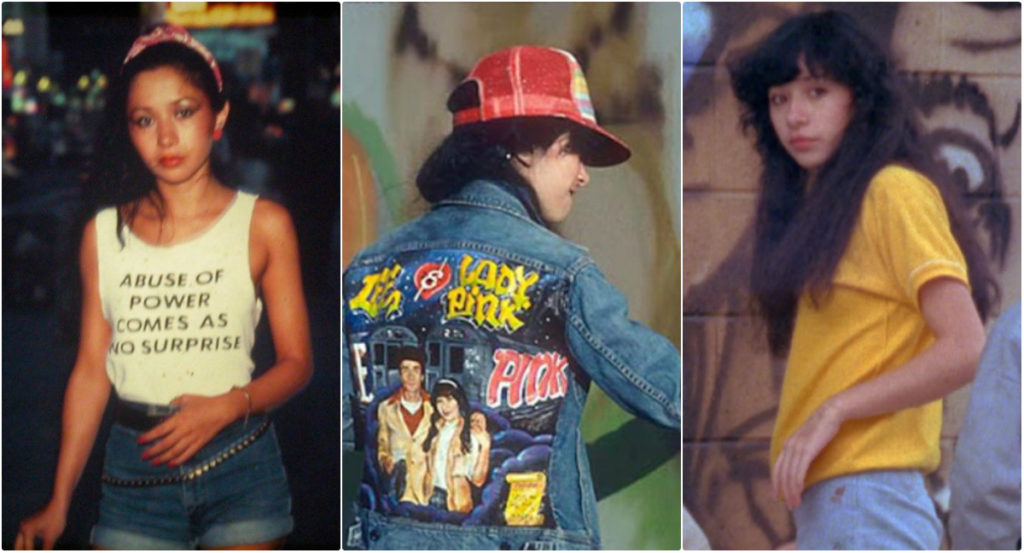As one of the most important artists of the Modern Era, Lady Pink was instrumental in exposing graffiti to the world while breaking ground for the art form. Born in Ecuador, this gifted artist moved to NYC and began panting subway trains from 1979-1985. She was and still is a respected and well-known graffiti writer who held her own during a time when female graffiti writers were far and few.
Internationally known for her starring role in the legendary film by Charlie Ahearn, Wildstyle, she eventually expanded her repertoire to include Fine Arts. She uses canvases and paint brushes just as easily as an airbrush or spray-can. Her artwork has appeared at The Moore College of Art, the Met and the Metropolitan Museum of Art, to name a few. She continues to make an impact through her murals and community wall work she does for free. She also passes on over twenty years of knowledge by holding lectures across the Northeast and teaches mural workshops for the youth.
AskHipHop had the opportunity to speak this legendary artist and as she added her unique splash of color and words of wisdom on everything from her views on Hip Hop to giving a full synopsis of the term, Wildstyle.
AHH: What was it like being a female amongst a male dominated art form especially at the beginning of the Hip Hop culture?
To be clear, I am not a pioneer of the graffiti culture; graffiti culture was already more than a decade old when I came into it. I am about the third maybe even the fourth generation. It was well established and strong by the time I came into the scene in 1979. There were already a lot of women that blazed some trails earlier on even in 1962, like Charming, Stony and ZEE. There are a whole lot of girls who did a lot of tagging, getting up and a little bit of trains; nothing too elaborate or large but there was a lot of history before me.
AHH: What inspired you to pick up your first can of spray-paint?
I started at the age of fifteen when my first boyfriend was arrested for graffiti. He was sent to live in Puerto Rico and I was mourning his loss…writing his name around the school, learning the basics of graffiti from his friends. Then I moved on to the High School of Art and Design. There were hundreds of graffiti writers there and I met the people that were doing it. They actually knew how to get in the subway yards so by the age of sixteen, I was doing subway cars.
AHH: This type of artistic expression was considered forbidden and illegal so what were some of the dangers involved while you were painting subway trains in NYC?
The dangers are the same today. Kids lose their lives and the police were always after you. Being a female underground, I ran into bigger dangers because you could get overwhelmed by a larger group of graffiti writers that are looking to take your paint, your sneakers, maybe the girl in your crew. There were huge dangers crawling around in tunnels and the yards. In the early eighties, NYC was still untamed from the economic problems we had during the seventies. There was still a lot of crime; the night belonged to the men folk. I was a very small woman and they parked the trains in the way out in the ghettos and creepy parts of town so it was extremely dangerous.
AHH: When you were doing this were you usually the only female in the crew?
Well, out of approximately 10,000 guys in NYC when I was doing it, I was probably the only female doing it; others girls came and went just for a short spell. I was a close friend with one other girl who would get up on trains in a pretty way – Lady Heart. There were other girls who were trying to make their name throughout town by tagging and getting up. It’s hard for me to say if I was completely the only girl but it certainly seemed that way.
AHH: I wanted to get into Wildstyle a little bit. Did you have any idea that movie would have the impact that it did, exposing wider audiences to Graffiti and Hip Hop Culture?
No, absolutely not. The director was just a cool white dude with money who had some kooky project up his sleeve but then hundreds of people did. All kinds of folks were coming out the woodwork in the early eighties with money wanting to do this project and that project. No one really took it very seriously; no one imagined it would go anywhere. We were doing it just for the fun of it because Charlie was a really cool dude. He hung out with us, he was a friend and we were just doing his thing. There were so many projects going on that no one ever imagined it would really go anywhere.
AHH: How did Charlie approach you about the Wildstyle project?
I was about sixteen years old when I met Charlie; I have no memory of any of that. Like I said he was a friend and we were hanging in the same scene, clubs and parties. I can’t remember how we met or how he introduced the film.
AHH: Do you keep in contact with the other artists in the movie? If so, have you all done any new work together?
Over the past thirty years, we have been exhibiting together and we see each other all the time. We do projects with each other. In just a couple weeks, I am doing a project for Charlie Ahearn. We collaborated on the movie and now we are doing something else. We are life long friends.
AHH: The movie Wildstyle made the actual mural famous but we also understand that Wildstyle is a style of graffiti writing. Could you tell us a little more about that style of graffiti art?
In New York City graffiti, there is a specialty in spray-paint, fonts and stylized letters. At first, it began in a bubble style…very simple, kind of puffy. By the mid-seventies, they were growing in elaborate shapes and arrows stylized in a way that excluded the general public from reading it. It became an inside thing and one had to learn and study reading this type of lettering in order to even decipher what was going on.
The Wildstyle lettering definitely became what it really means. The letters are wild. But there is a particular way of going wild with the letters. You can’t just run a muck. You have to study, learn and practice because an expert will immediately pick you out as an amateur if you don’t know how to handle your letters. One wrong line, one wrong curve too extreme, one arrow shaped incorrectly; I mean instantly an expert will know. If you are just starting out you need to be schooled. We teach master to apprentice…someone has to teach you. You can pick it up a little bit from books but you’re still not going to understand the correct way letters are shaped and supposed to be… Not to say everyone is a cookie cutter, copier of letters and everyone does the exact same letters. You have to master that style, find your own style and be original within the standards of graffiti lettering.
Graffiti lettering ranges in different styles from different countries. Each country has their own specialty so you can identify folks by the way they speak and the way they handle the letters and how they stylize their names. So it is a very specific kind of artwork that young people have to study for many years to master.
AHH: What changes would you say have taken place in relationship between Hip Hop and Graffiti over the years?
Well marketing corporations and the media invented the word Hip Hop because they like to be able to describe something. We share the same grassroots start; we were all a folk art in the beginning. Graffiti writers are very fierce and protective of their culture. It is purely about art and vandalism, it doesn’t have anything to do with the dancing or the music and they have lumped us up all together and collectively called us Hip Hop. We are not really Hip Hop. No one can exactly define what Hip Hop is and what makes us Hip Hop? It is certainly not something we can take lightly as a fashion like I am going to be Hip Hop now. I’m gonna dress correctly and listen to the right music…it has nothing to do with that. This is about teaching kids how to do a crime, how to evade the police, how to live on the lamb, how to steal and lie and basically become a criminal if you are teaching graffiti. That is the stigma.
Hip Hop is more of the entertainment world… its about the music, dancing, gigs, costumes, managers, payment and the commercial world. We differ and in New York City, it depends on what neighborhood you came from that you were exposed to Hip Hop at all. If you came from certain neighborhoods, all you heard was rock ‘n’ roll and you would not hear any rap music or break dancing. But we are subjected to the stereotypes and they jam the rap music down our throats wherever we appear. Folks assume we are Hip Hop and therefore all we listen to is rap music when it isn’t true at all. Each individual artist is so focused on their artwork and what they do, they are not subjecting themselves to being the stereotype or listening to the correct music because that is what your supposed to be listening to or be down with. We have no choice on what people want to label us. We call ourselves artists or graffiti writers and all the other folks call us Hip Hop people. They call me a Hip Hop pioneer when I was just painting trains, doing my art and hanging around the artists on the gallery scene and in the clubs. About me being a Hip Hop pioneer…I don’t really feel that, I don’t want to take responsibility or blame for the birth of a movement that degrades and demeans women.
AHH: So you feel Hip Hop still does that till this day?
Even though women are gaining ground, yes unfortunately.
AHH: Did you listen to any Hip Hop artists growing up?
In the very beginning when everything was just popping off we were all amused about the Sugar Hill Gang record and we all listened to that and it became popular. It was just everywhere in New York City. We got to witness it because it was happening around the scene and movies were being filmed but privately we all listened to our own music. But with Hip Hop, no I never really caught on to all that… it was being played at the clubs where we were going but I started off listening to disco in the seventies and rock ‘n’ roll. I am a rock ‘n’ roll head.
AHH: How has your style evolved over the years since you have taken the art of graffiti to unbelievable heights? Where do you see it going in the future?
I am reluctant to call what I do graffiti in anyway. I have not done graffiti in well over a decade. So I would not like to describe what I do as graffiti; that does a disservice to the artwork I do. The artwork doesn’t have anything to do with graffiti anymore. Sometimes I use the medium of spray-paint when doing my artwork but otherwise I mostly use a paintbrush. So to be precise, what I am doing is artwork. If it’s on canvas for exhibits, if it’s on a mural, its public art…its still artwork. Its not street art, so people should not confuse it with street art just because it is in the street. With permission, with funding, it’s legal.
What I see for the future is me exhibiting and doing bigger projects with my artwork. I exhibit in museums and I do mural installations all over the place so I don’t really plan ahead, I just go with the flow. I never really planned ahead or had grand ambitions. What I see in the future is doing less work. For thirty years, I have been holding the fort, representing and always having to step up to bigger and larger things and it gets a bit tiring. I am just thrilled that there are a lot more females that can carry the torch and represent for the girls. There are always things going on and people are like, we need a girl lets call Lady Pink. I was always the token female. I am tired of representing for the ladies cause if I didn’t show up there were no girls at all. So I had to represent for the girls and be strong. It gets a little tiring having to be strong all the time…for heavens sakes, I need a little time off.
This year, I am not accepting any graffiti events. Just art events and other events not graffiti I am just getting a little tired of representing for that. There are amazingly wonderful and talented fun people that are just a joy to know but unfortunately we carry a lot of riff raff. HATERS…people who are just envious, jealous and want to destroy anything that they see is becoming successful.
Take a wonderful space like 5 Pointz for example – it’s a huge space and that gets it collection of haters that breeze by and destroy all the nice looking work from anybody or everybody. They just don’t care. They want to be horrible and hateful and after so many years of having to tolerate and put up with hateful nasty people…unfortunately that is some of what the culture attracts, chaos. Not all of us are upstanding citizens and some are just worse than others. There is no way that some artists can police themselves. You just can’t. You can just hope karma will catch up to them and they will end up in jail for twenty-five to life or dead in the gutter where they belong and eventually it does. You just have to outlast them and go about your thing, ignore them and the will go away. Eventually they will.



